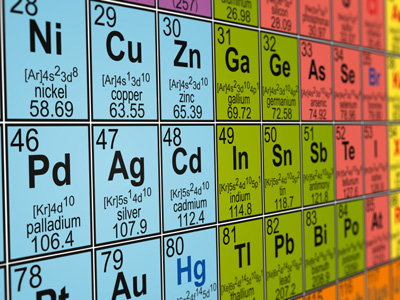
Chemistry - The Periodic Table (AQA)
A basic understanding of the fundamental ideas in chemistry is required of students in GCSE Science. This is the second of six quizzes going over these fundamental ideas and it looks specifically at the periodic table.
The periodic table is a fundamental part of chemistry and we take it and its usefulness for granted, but that hasn't always been the case. In the first half of the 19th Century, various people had been trying to make sense of the elements and see if there was any order amongst them. Scientists had spotted that there were some similarities in the way that some elements behaved during chemical reactions, but not enough to create anything other than a few simple patterns. A big problem was that many elements had not been discovered at the time. It was a bit like trying to set out a jigsaw of over 100 pieces using only about 30 random pieces (including several from a different jigsaw) and having no picture to work from! Some scientists still believed that there were only 4 elements - those decided on by the ancient Greeks - fire, earth, air and water!
A French scientist, Antoine Lavoisier, gathered together a list of everything that he believed to be an element in 1789 - but in no particular order. An element was defined as a substance that could not be broken down further so some of his elements were in fact compounds. Following the discovery of electricity the British scientist, Humphrey Davy, experimented with passing it through the elements on Lavoisier's list. In doing this he found that some of them could in fact be broken down into simpler substances, the list of true elements increased.
When scientists learnt to measure the atomic masses of elements, they started to use this property to arrange the elements. A German chemist, Johann Döbereiner, spotted that there were groups of three elements that seemed quite similar in their properties and noted that the atomic mass of the middle one was the average of the other two. He had spotted the start of several of the periodic table groups.
A British scientist, John Newlands, took it further. He arranged the elements in order of atomic mass and noticed that every eighth element seemed to behave in a similar way. Finally, the key step was taken by a Russian, Dimitri Mendeleev. His ideas were similar to Newlands' and he arranged the elements in order of their atomic mass. The difference was that he left gaps where he thought that elements had not been discovered. When the first of these 'missing elements' was found and seen to have the properties Mendeleev predicted, scientists in the world of chemistry knew he was onto something.
Since then, scientists have started to understand atomic structure. The modern periodic table is arranged in order of atomic number. We now know that it is the electrons and how they are arranged that give the elements their chemical properties.
Ready for more?
not all...
quizzers. Try to win a coveted spot on our Hall of Fame Page.







